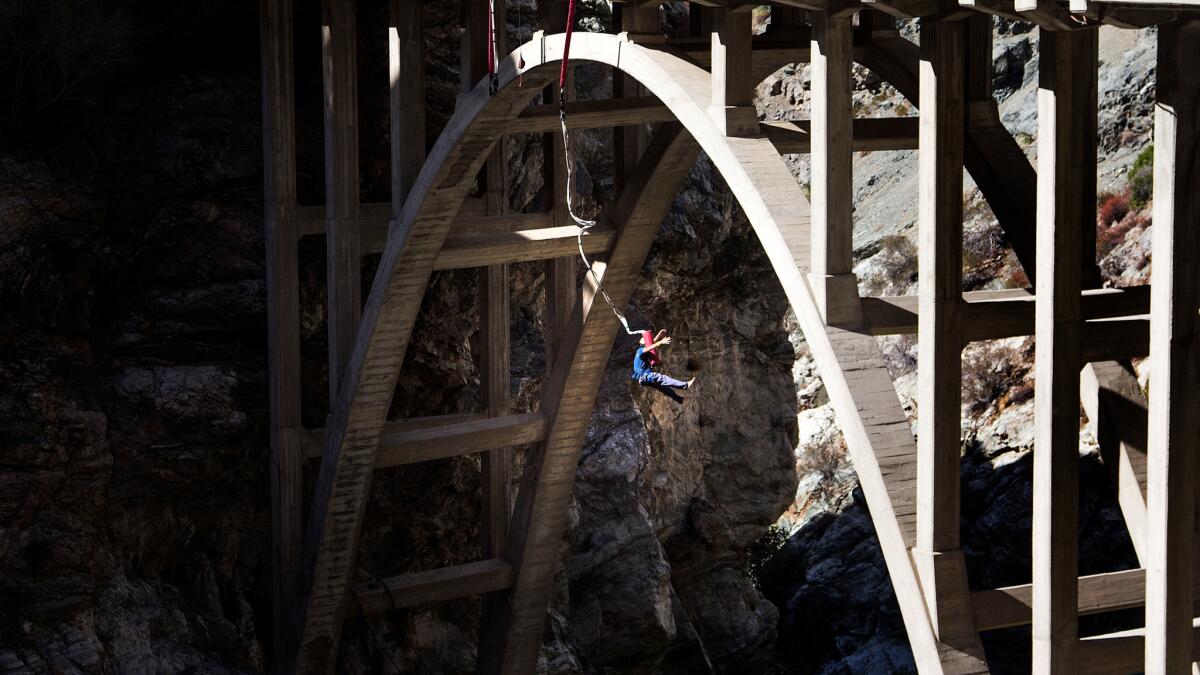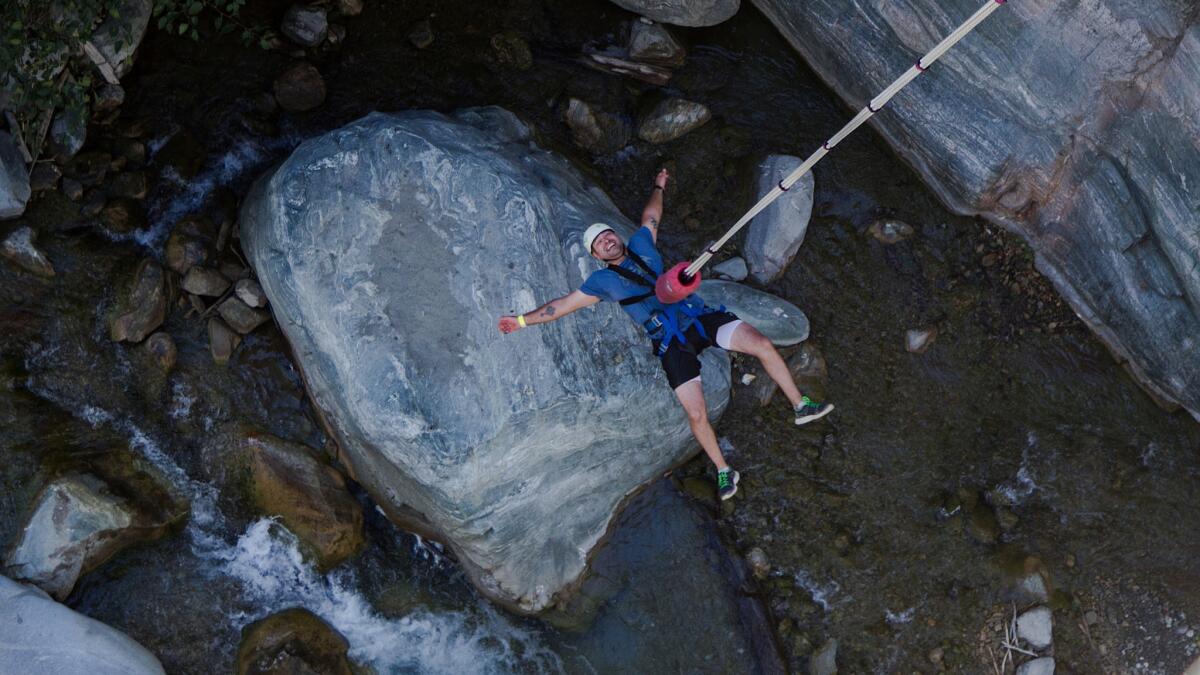Here’s why that bungee jumping business at the Bridge to Nowhere is still hanging in there
The woman threw her leg over the bridge railing, nudged her hiking boots to the edge of a small metal platform and stared at the boulders 120 feet below.
Behind her the chant began: “Five, four, three, two, one … .”
For the record:
9:56 p.m. Nov. 5, 2024A previous version of this article described the East Fork as a federally designated Wild and Scenic River. The Forest Service has found the East Fork eligible for that designation.
The woman froze. Gave an embarrassed smile. She just couldn’t do it, she said, scrambling awkwardly back over the rail.
A few minutes later, she tried again. “Five, four, three … . ” No go.
And again.
Only after her sixth attempt to leap from this famous landmark deep in the San Gabriel Mountains did she concede that perhaps she would have to come back and try another time.
There’s a good chance that won’t be possible, though.
Since 1993, thousands of people have hiked five miles up the rugged East Fork of the San Gabriel River to launch themselves off the famous Bridge to Nowhere. And they’ve paid Bungee America, Southern California’s only commercial bungee jumping operation, for the privilege.
Now, two years after President Obama officially set aside 364,000 acres of the surrounding mountains as a national monument, opponents say it’s long past time to shut the operation down.
The Forest Service and extremist environmentalists have been doing everything they can to take control of my property.
— Ron Jones, owner of Bungee America
Ron Jones, who owns the business 20 miles north of Azusa, takes comfort in the fact that environmentalists along with the U.S. Forest Service and other regulatory agencies, have been trying to do that for years with no success.
“The Forest Service and extremist environmentalists have been doing everything they can to take control of my property,” he said. “But that will never happen. I’ll still be here after the dust settles and my opponents are pushing up daisies.”
Critics contend that Bungee America imperils public safety, damages the environment and operates without required permits. They are also concerned that effluent from an 80-year-old brick outhouse at the bridge may be making its way into the East Fork, which the Forest Service has found to be eligible for designation as a Wild and Scenic River.
The problem that has people most riled at the moment, though, is quintessentially Southern Californian: parking.
Each weekend, critics complain, Jones customers take up most of the spaces in a trailhead parking lot meant to serve visitors who come to picnic, swim in the nearby river, ride bicycles and hike.
Most folks can’t even find a place to park at the East Fork trailhead on weekends because they are taken up by Jones’ customers.
— Paul Ayers, attorney for Save the East Fork

The controversy revolves around a former gold mining claim. The bridge was built on it around 1936 as part of a state road project up the East Fork. The road project was abandoned in 1938 after destructive flooding.
But the bridge remained, a spectacular incongruity in the otherwise natural watershed.
Jones, an outdoorsman who has been featured bungee jumping on “Ripley’s Believe It or Not” and other TV shows, discovered the thrills of plummeting from the bridge and turned the experience into a business in 1993.
He bought the 50-acre parcel in 2009 from descendants of a family that once ran a gold mine there, he said. Los Angeles County assessor’s office records show that the property sold for $242,570.
State health and safety officials first tried to shut down Jones’ operation in 2000, citing such issues as lack of liability insurance and an expired license to operate as an amusement ride.
A year later, an inspector from the state Division of Occupational Safety and Health visited the site and renewed its license.
In 2014, opponents pointed out that the site is in an unincorporated county area zoned for agriculture, which does not permit commercial amusement businesses. Jones persuaded the L.A. County Board of Supervisors to approve a zoning change from agricultural to commercial.
It makes skydiving feel like taking a nap.
— Andrew Albrecht, “adrenaline junkie”

He also requested a Clean Hands Waiver, which would allow the venue to continue operating pending completion of a conditional use permit process with the county Department of Regional Planning.
A final determination on Jones’ waiver request is expected by the end of October, Oscar Gomez, the planning department’s supervising regional director said. If the request is denied, Jones will be required to remove equipment and facilities connected to the venue until the lengthy conditional use permit process is completed, county officials said.
But that’s not the only regulatory threat to Jones’ business.
On Oct. 18, the Los Angeles County Department of Public Health ordered Bungee America to cease commercial use of a chemical toilet at the site. Jones may apply for a public health permit to use a chemical toilet there after he has secured a Clean Hands Waiver, or a conditional use permit from county regional planners, officials said.
Jones was unavailable for comment on that notice of violation.
On Oct. 5, the California Department of Transportation’s aviation division issued a cease-and-desist order prohibiting Bungee America from using an unpermitted heliport on his property. Jones has relied on a helicopter to remove waste from the outhouse, deliver supplies to his crews and transport a state inspector from Cal/OSHA’s amusement ride division to the site to do an annual inspection required to renew his operating license.
Jones says none of that will stop him.
The outhouse issue? “If I can’t use helicopters, I’ll carry the waste out in a backpack,” Jones says.
And Julia Bernstein, a spokeswoman for Cal/OSHA, acknowledged that her agency’s inspectors have made the arduous trek to the business before, “and we have no plans to stop inspecting it in the future.”
Paul Ayers, an attorney representing the nonprofit environmental group Save the East Fork, calls Jones’ enterprise an inappropriate use of a federal wilderness area meant to serve all of the 15 million people living within a 90-minute drive.
“Most folks can’t even find a place to park at the East Fork trailhead on weekends because they are taken up by Jones’ customers,” he said.
For their part, the 30 or so jumpers who made the two-hour trek to the bridge last Sunday seemed unconcerned about either the legal issues or the imperfect restroom facilities. “We’re using the bushes,” one said.
Andrew Abrecht, 30, described the $250 he paid for three jumps as “some of the best money I’ve ever spent.”
“I’m an adrenaline junkie — I race stunt cars and go skydiving,” he said, “But I’d never tried bungee jumping until today. And, man, it makes skydiving feel like taking a nap.”
“If I had more money, I’d jump a few more times,” he added with a grin.
ALSO
Ex-teacher slits his throat in O.C. court after being convicted of raping girl
Why business groups aren’t fighting California’s tobacco and income tax hike initiatives
Deputy killed in Modoc County — the 4th on-duty California police officer to die in 2 weeks
UPDATES:
Oct. 26, 2016, 2:40 p.m.: This article was updated with information on the Los Angeles County Department of Public Health’s Oct. 18 order involving the chemical toilet.
More to Read
Sign up for Essential California
The most important California stories and recommendations in your inbox every morning.
You may occasionally receive promotional content from the Los Angeles Times.











